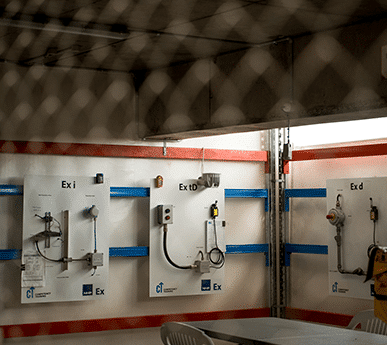The Basic Principles Of Roar Solutions
The Basic Principles Of Roar Solutions
Blog Article
Getting The Roar Solutions To Work
Table of ContentsThe Roar Solutions IdeasAll About Roar SolutionsThe Best Strategy To Use For Roar Solutions
In order to shield installments from a possible explosion a technique of evaluating and classifying a possibly hazardous location is called for. The objective of this is to make sure the right selection and setup of tools to ultimately protect against an explosion and to guarantee safety of life.
(https://www.imdb.com/user/ur192566418/?ref_=nv_usr_prof_2)
No devices needs to be set up where the surface area temperature level of the equipment is above the ignition temperature level of the provided risk. Below are some common dust hazardous and their minimal ignition temperature. Coal Dust 380C 225C Polythene 420C (melts) Methyl Cellulose 420C 320C Starch 460C 435C Flour 490C 340C Sugar 490C 460C Grain Dirt 510C 300C Phenolic Resin 530C > 450C Aluminium 590C > 450C PVC 700C > 450C Residue 810C 570C The probability of the threat existing in a focus high sufficient to cause an ignition will certainly vary from place to location.
In order to categorize this danger an installation is separated right into locations of risk depending upon the amount of time the hazardous is present. These locations are described as Zones. For gases and vapours and dusts and fibres there are 3 zones. Zone 0 Area 20 An unsafe atmosphere is very likely to be present and may exist for lengthy periods of time (> 1000 hours each year) or also continuously Zone 1 Area 21 A dangerous environment is feasible yet not likely to be present for extended periods of time (> 10 450 C [842 F] A classification of T6 indicates the minimum ignition temperature is > 85 C [185 F] Dangerous area electrical devices possibly made for usage in greater ambient temperatures. This would certainly suggested on the rating plate e.g. EExe II C T3 Ta + 60C( This means at 60C ambient T3 will not be gone beyond) T1 T1, T2, T3, T4, T5, T6 T2 T2, T3, T4, T5, T6 T3 T3, T4, T5, T6 T4 T4, T5, T6 T5 T5, T6 T6 T6 A T Class score of T1 implies the optimum surface temperature generated by the instrument at 40 C is 450 C. Presuming the connected T Course and Temperature rating for the tools are proper for the location, you can constantly use a tool with a more strict Department rating than needed for the location. There isn't a clear solution to this inquiry however. It really does depend on the type of equipment and what repair services require to be executed. Equipment with particular test procedures that can't be performed in the area in order to achieve/maintain 3rd party ranking. Must return to the factory if it is before the devices's service. Area Repair Work By Authorised Employee: Complicated screening might not be required however particular treatments may require to be complied with in order for the devices to keep its 3rd party rating. Authorized employees have to be employed to execute the work properly Fixing need to be a like for like replacement. New component need to be thought about as a direct replacement requiring no unique testing of the equipment after the repair is complete. Each piece of equipment with a harmful score need to be reviewed individually. These are laid out at a high level below, yet for more in-depth info, please refer directly to the standards.
See This Report about Roar Solutions
The devices register is an extensive database of devices records that consists of a minimum set of fields to identify each thing's area, technological specifications, Ex lover classification, age, and environmental data. The ratio of Detailed to Shut inspections will be determined by the Tools Threat, which is examined based on ignition risk (the possibility of a resource of ignition versus the likelihood of a combustible environment )and the harmful location classification
( Zone 0, 1, or 2). Applying a durable Risk-Based Assessment( RBI )approach is crucial for making sure conformity and safety in handling Electric Devices in Hazardous Locations( EEHA).
About Roar Solutions

In regards to eruptive risk, a harmful area is an atmosphere in which an explosive atmosphere this link exists (or might be anticipated to be existing) in quantities that call for unique precautions for the building and construction, installation and use of devices. eeha certificate. In this write-up we check out the difficulties encountered in the workplace, the danger control measures, and the needed proficiencies to work safely
It is a consequence of contemporary life that we make, keep or deal with a range of gases or fluids that are considered flammable, and a variety of dirts that are considered flammable. These compounds can, in particular conditions, form eruptive environments and these can have significant and awful consequences. A lot of us know with the fire triangle get rid of any kind of one of the 3 elements and the fire can not occur, however what does this mean in the context of harmful areas? When damaging this down right into its simplest terms it is essentially: a combination of a certain amount of launch or leakage of a specific substance or product, blending with ambient oxygen, and the visibility of a source of ignition.
In the majority of instances, we can do little about the degrees of oxygen in the air, however we can have substantial impact on sources of ignition, as an example electrical tools. Harmful areas are recorded on the unsafe location classification illustration and are recognized on-site by the triangular "EX" sign. Here, among other key information, areas are split right into 3 kinds relying on the danger, the probability and period that an explosive ambience will certainly exist; Area 0 or 20 is considered one of the most unsafe and Area 2 or 22 is regarded the least.
Report this page